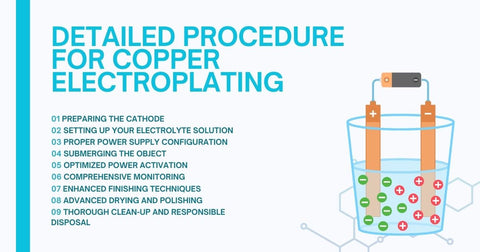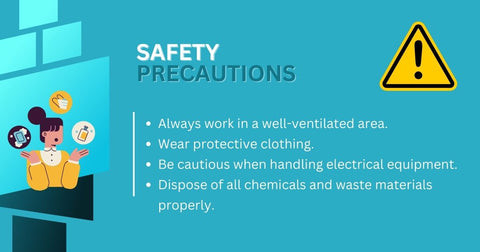Copper electroplating is a fascinating process that combines the art and science of coating metals with a thin layer of copper. This technique has a myriad of applications, from enhancing electrical conductivity to making unique art pieces.
In this deep dive, we'll explore how copper electroplating works, how you can do it at home, the materials you'll need for a lab setup, and the essential safety precautions to keep in mind.
What is Copper Electroplating?
At its core, copper electroplating involves passing an electric current. This is done by dipping an object through a solution called an electrolyte, leading to the deposition of copper onto a conductive surface. This process relies on the principle of electrolysis. Where an anode (copper metal) and a cathode (the object to be plated) are submerged in an electrolytic solution containing copper ions.
When the electric current is applied, copper ions from the solution are reduced at the cathode's surface, forming a thin, solid copper layer. Simultaneously, at the anode, copper metal dissolves into the solution, maintaining the concentration of copper ions. This careful balance ensures a smooth and even coating.
Applications of Copper Electroplating
Copper electroplating finds applications across various industries, highlighting its versatility and importance. In electronics, it's used to create conductive layers on circuit boards, enhancing electrical performance. In manufacturing, copper plating is applied to improve the wear resistance and corrosion protection of metal parts. Additionally, copper electroplating is used in decorative applications, giving objects a shiny, appealing copper finish.
Comprehensive Guide to Copper Electroplating for DIY and Lab Applications
Copper electroplating is a fascinating, educational, and practical project that can be undertaken in both home and lab environments. This expanded guide delves deeper into the process, providing detailed instructions and additional insights to ensure a successful copper plating outcome, no matter where you are.
Materials Needed
- High-Quality Copper Sulfate Solution: Acts as the electrolyte in the electroplating bath.
- Pure Copper Anode: A copper strip or rod that will be dissolved into the solution, providing the copper ions needed for plating.
- Conductive Object (Cathode): The item you intend to plate with copper. It must be conductive to allow the flow of electrons.
- Power Supply: A battery can suffice for DIY setups, while a regulated DC power supply is recommended for more precise lab applications.
- Safety Equipment: Gloves and goggles protect your skin and eyes. Ensure the area is well-ventilated to avoid inhalation of fumes.
- Measuring and Monitoring Tools: For those in a lab setting, devices to monitor the solution's pH, temperature, and copper ion concentration are invaluable for maintaining optimal conditions.
- Cleaning Supplies: Degreasers, acetone, and brushes for pre-treatment of the cathode.
- pH-neutralising agents: Use something like baking soda for post-treatment and rinsing the plated object.
- Polishing Tools: Soft cloths and appropriate polishing compounds for finishing the plated surface.
- Protective Coating Materials: Clear lacquer or other suitable sealants to protect the plated surface from tarnishing and wear.
Detailed Procedure For Copper Electroplating

1. Preparing the Cathode
Begin with meticulously cleaning the cathode to remove all contaminants. Consider using an ultrasonic cleaner to reach all nooks for objects with intricate designs. If rust or heavy oxidation is present, a more abrasive method may be needed before proceeding to the degreasing stage.
2. Setting Up Your Electrolyte Solution
The quality of your electrolyte solution dramatically affects the final plating quality. Consider heating the solution for lab applications to increase solubility and create a more uniform plating. Moreover, adding a small amount of sulfuric acid helps improve conductivity and the adherence of the copper layer.
3. Proper Power Supply Configuration
Use a power supply with variable voltage and current settings for more complex projects. This allows for precise control over the plating process and accommodates different sizes and shapes of cathodes.
4. Submerging the Object
Position the anode and cathode correctly for even plating. Ensure that there is sufficient distance between them to allow for an even distribution of copper ions. For large or irregularly shaped objects, consider using multiple anodes.
5. Optimised Power Activation
Start the process at a lower voltage to help prevent initial deposition irregularities. Gradually increase the voltage to achieve the desired plating rate without compromising the smoothness of the copper layer.
6. Comprehensive Monitoring
Regularly inspect the object during the plating process. Look for signs of uneven plating or discoloration. Which may indicate adjustments are needed in the power supply or electrolyte composition.
7. Enhanced Finishing Techniques
Rinse your cathode thoroughly after achieving the desired thickness. This neutralisation step is vital for preventing future corrosion or degradation of the copper layer. Moreover, you can accelerate the drying process by using compressed air or a gentle heat source to prevent water spots.
8. Advanced Drying and Polishing
To achieve a mirror-like finish, combine mechanical and chemical polishing. Consider using a rotary tool with a polishing wheel for initial buffing, followed by manual polishing with a microfiber cloth and a suitable compound.
9. Thorough Clean-up and Responsible Disposal
Environmental responsibility is key. Ensure that all waste, including used electrolyte solution and disposable protective gear, is disposed of according to local regulations. Store reusable materials properly to prevent cross-contamination.
Safety Precautions
While copper electroplating is widely practised, it's essential to approach the process with a keen awareness of safety. The chemicals can be hazardous, and the electrical components require careful handling. Key safety precautions include:
- Always work in a well-ventilated area to avoid inhaling fumes from the electrolyte solution.
- Wear protective clothing, including gloves and goggles, to prevent skin and eye contact with harmful substances.
- Be cautious when handling electrical equipment, ensuring all connections are secure and using a power supply with appropriate safety features.
- Dispose of all chemicals and waste materials according to local regulations.

Conclusion
Copper electroplating is a remarkable process that blends chemistry, physics, and engineering to create functional and aesthetic coatings on various objects. Whether undertaken at home or in a lab, it offers a hands-on way to understand the principles of electrochemistry and material science. By following the guidelines for materials, setup, and safety, enthusiasts and professionals alike can explore the benefits of copper electroplating, contributing to advancements in technology and manufacturing.




